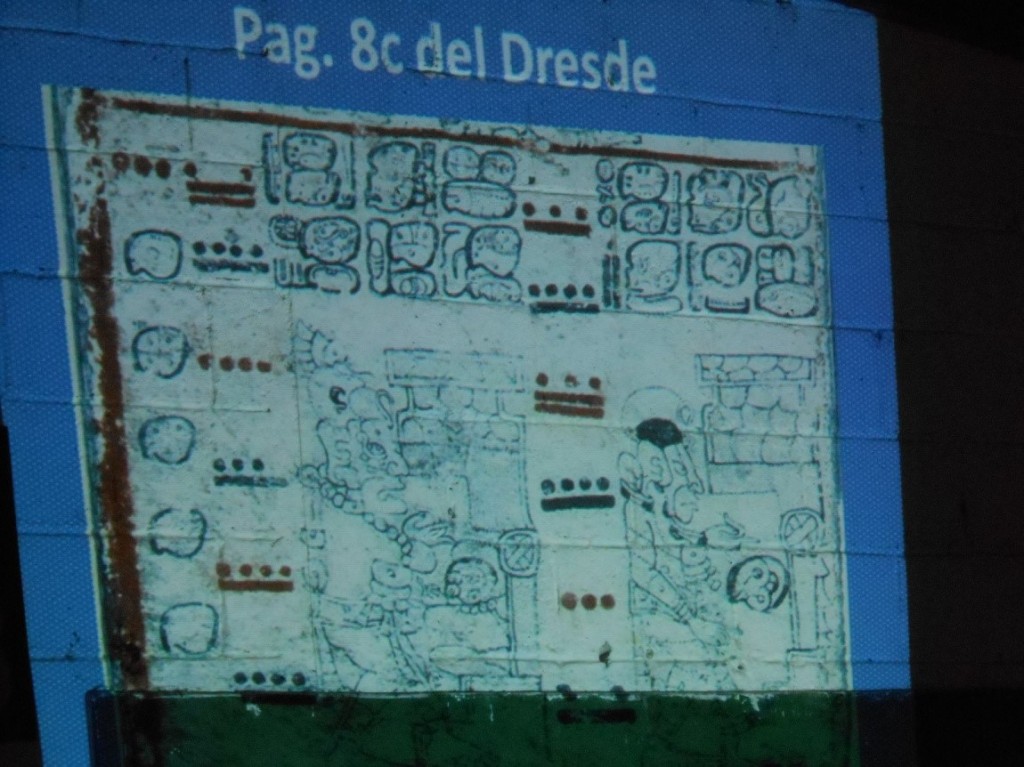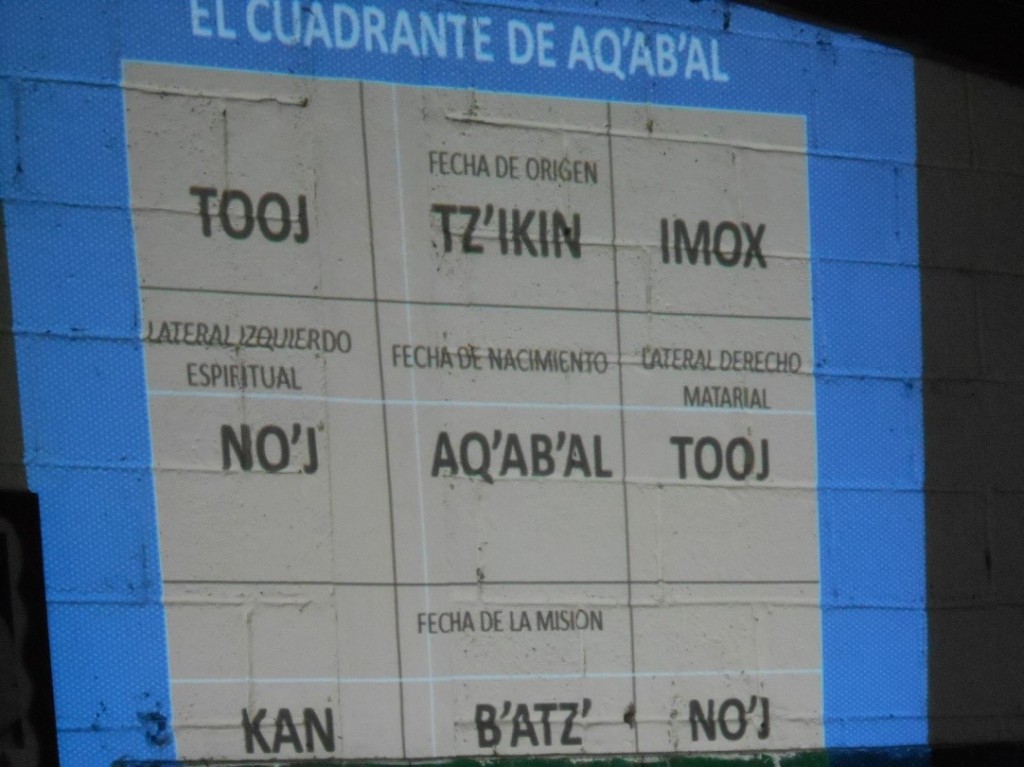FIRST WORKSHOP FOR ACHI MAYA
by
Andrés Cholotío, Executive Director of PLFM Foundation (Proyecto Linguistico Francisco Marroquín)
Summary
Brief overview of the activities at the workshop held in Cubulco, Baja Verapaz, Guatemala, July 14, 2013 [thanks, in part, to a grant from the donors at MAM].
Topics: The calendars from the codices and how to write in glyphs.
Organizer: Andrés Cholotío García and the Achi Linguistic Community.
Instructors: Clemente Maximiliano Peneleu and Hector Xol.
General Objective: Learning the knowledge of our grandmothers and grandfathers by means of deciphering the codices and the writings of the various texts that have been found.
Specific Objective: Develop the knowledge of the calendar found in the codices and apply it to everyday life. Apply the knowledge of epigraphy in today’s writing and discover the legacy of cosmic knowledge in it.
PRIMER TALLER SOBRE GLIFOS PARA MAYA ACHI
por
Andrés Cholotío, Director Ejecutivo de la Fundación PLFM (Proyecto Linguistico Francisco Marroquín)
Resumen
Breve resumen del las actividades en el taller desarrollados en Cubulco, Baja Verapaz el día 14 de julio del 2013 [gracias, en parte, a una beca de los donadores de MAM].
Temas: Los calendarios desde los códices y como escribir en glifos.
Coordinación: Andrés Cholotío García y la comunidad lingüística Achi
Expositores: Clemente Maximiliano Peneleu y Hector Xol.
Objetivo General: Desarrollar el aprendizaje de los conocimientos de nuestras abuelas y abuelos mediante el desciframiento en los códices y escrituras en los diferentes escritos encontrados.
Objetivo Específico: Desarrollar el conocimiento del calendario que se encuentra en los códices y así aplicar en la vida cotidiana. Aplicar el conocimiento de la epigrafía en la escritura actual y descubrir el legado de conocimientos cósmicos dentro de ella.
The Event
Prior to the event, the workshop was coordinated with the Achi Linguistic Community in order to invite the participants and arrange for the space where the workshop would be held.
At the beginning there was a brief invocation for the energy of the day, which was One Kan, so that all the activities that had been developed would come out as planned.

Andrés Cholotío (front) made the introductions: for Teletor Velásquez (behind), President of the Achi Linguistic Community, and for Bruce Love who accompanied the group to Cubulco, Baja Verapaz.
Love spoke a few words to the participants in which he said he was very happy to be sharing this time with the Achis.
To begin, Clemente Peneleu began with his topic, the calendars in the codices. In this presentation he introduced how the calendars in the codices are interpreted, taking days from the past and comparing them with today’s days.

From right to left: Denis Estuarlin Teletor Ajualip, Irene Eugenio Mejía Taperia, Mateo Ajualip Rodríguez and behind, Bruce Love paying close attention to what was being explained.

In the research that Clemente Peneleu had done, he found that all the twenty days of the ritual calendar are bearers (cargadores). They each have their own energies. Therefore each one of us needs to keep on studying to arrive at an understanding of what the codices are saying.

From right to left: Denis Estuarlin Teletor Ajualip, Irene Eugenio Mejía Taperia, Mateo Ajualip Rodríguez, Maximiliano Corazón Xitumul, Abelino Román Lajuj, Marina Elcira Raymundo Ramírez, Lucas Isabel Mejía Taperia.
![It is interesting the teachings of the codices in which are found the ritual calendar, the readings of the days, how we can find the maya “cuadrant” [a concept perhaps yet unknown to Western epigraphers], etc.](https://discovermam.org/wp-content/uploads/2013/11/5-1024x767.jpg)
It is interesting the teachings of the codices in which are found the ritual calendar, the readings of the days, how we can find the maya “cuadrant” [a concept perhaps yet unknown to Western epigraphers], etc.
Maya Hieroglyphic Writing
This presentation was conducted by Hector Xol, beginning with some history of Maya writing and its decipherment.
In the Preclassic Period is when the first writings appeared, around B.C. 500. Then in the Classic Period is the time of the major development of the hieroglyphic writing, in the great cities like Tikal, Calakmul, Palenque, Copan and others.

Workbooks and handouts were distributed, which Hector had made, so the participants would have the necessary tools to understand the ancient writing.
Included in this material was the syllabary, which is very important for the hieroglyphic writing, so that the participants could understand the application of the syllabary.
It was explained how to write a word, what is the proper order of the signs. Hector showed how certain words could be written in order to put into practice what he had been teaching.

From right to left: Maribel Teletor Camajá, Sonia Elisama Calo Ortíz, Diego Baltazar; segunda fila atrás: Manuela Esmeralda Raymundo Pablo, Trinidad Santiago Rodríguez, Silvestre Jimenez and Sebastián Taperia Reyes.
He said that the language closest to the ancient writing, and which is spoken today in Guatemala, is Ch’orti’.
The two forms of hieroglyphic writing are:
Logogram: when a sign represents a whole word, like the days of the ritual or agricultural calendars, and other words like b’alam and witz.
Syllable: the parts with which the words are pronounced. Joining the syllables forms words.
Also, syllables can be combined with logograms to reinforce the logogram.
Each of the workshop teachers focused on understanding the use of the syllabary and the order in which they are used to write.

As part of their exercises, the participants learned how their names should be written, or the names of the towns they were from.
The original invitations were for 35 people but in the end 55 showed up, having such a great interest in learning and knowing about the history of the ancient writing of our civilization.
Conclusions
1. The invitations that were made were very well received on the part of the community, based on the participation we had.
2. Coordination with the authorities of the linguistic community was very good, based on the results obtained.
3. There is great interest in the community over the learning of Maya hieroglyphic writing.
4. The teachers showed excellent control over their subjects of hieroglyphic writing and the Maya calendars.
5. There should be continuing workshops on Maya epigraphy.
Previo del desarrollo del taller se coordinó con la comunidad lingüística Achi para la convocatoria de los participantes y el lugar en donde se desarrolló el taller.
Al inicio de la actividad se hizo una breve invocación por la energía del día que es Jun Kan, para que toda la actividad a desarrollarse saliera como estaba planificado.

Andrés Cholotío (frente) hizo la presentaciónes: a Teletor Velásquez (presidente communidad lingüística achi’) y a Bruce Love que acompañó al grupo a Cubulco, Baja Verapaz.
Love dio unas palabras a los participantes y que se sentía muy contento de estar conviviendo unos momentos con los Achi’es.
Inmediatamente, Clemente Peneleu empezó con su tema, los calendarios en los códices. En esta presentación se dieron a conocer como se hacía la interpretación de los calendarios en los códices, tomando los tiempos atrás y haciendo una comparación con los tiempos de ahora.

De derecha a izquierda: Denis Estuarlin Teletor Ajualip, Irene Eugenio Mejía Taperia, Mateo Ajualip Rodríguez y atrás, Bruce Love muy atento a lo que se estaba exponiendo.

Dentro de la investigación que ha realizado Clemente Peneleu encontro que todos los veinte días del calendario ritual son cargadores, ese quiere decir que en estos tiempos deben de ser otros cargadores los que deben de entrar. Por lo que a cada uno de nosotros nos tocar seguir investigando para llegar a un entendido lo que dicen los códices.

De derecha a izquierda: Denis Estuarlin Teletor Ajualip, Irene Eugenio Mejía Taperia, Mateo Ajualip Rodríguez, Maximiliano Corazón Xitumul, Abelino Román Lajuj, Marina Elcira Raymundo Ramírez, Lucas Isabel Mejía Taperia.

Es interesante los conocimientos en los códices en donde se puede encontrar el calendario ritual, las lecturas de los días, como podemos encontrar el cuadrante maya, etc.
La Escritura Jeroglífica Maya
Para esta presentación lo condujo Hector Xol, comenzando con un poco de historia de la escritura jeroglífica y el desciframiento de la misma.
En el periodo preclásico es cuando aparecieron las primeras escrituras en los años 500 a.C. Ya en el período clásico es cuando se desarrolló mejor la escritura jeroglífica, en la grandes ciudades como Tikal, Calakmul, Palenque, Copan y otros.

Se les dio un material fotocopiado y un ejemplar de una publicación que se ha hecho, para que los participantes puedan tener las herramientas necesarias para entender sobre la escritura antigua.
Dentro de este material iba el silabario que es muy importante para la escritura jeroglífica, en donde los participantes se les fue explicando la aplicación del silabario.
Se explicó cómo debe escribirse una palabra, cual es el orden que debe de llevar.
También se les explicó cómo debería escribir algunas palabras en sus idiomas para poner en práctica lo que se les estaban enseñándoles.

De derecha a izquierda: Maribel Teletor Camajá, Sonia Elisama Calo Ortíz, Diego Baltazar; segunda fila atrás: Manuela Esmeralda Raymundo Pablo, Trinidad Santiago Rodríguez, Silvestre Jimenez y Sebastián Taperia Reyes.
Mencionó del idioma que está más cerca de la escritura antigua y que actualmente se habla en Guatemala y que es el ch’orti’.
Las dos formas de escritura de la jeroglífica maya son:
Logograma: es cuando una figura representa una palabra entera, como los días de los calendarios rituales y agrícola, y otras palabras más, como la palabra b’alam y witz.
Sílaba: los partes en que se pronuncian las palabras. La suma de sílabas forman las palabras.
También se puede combinar un logograma con sílabas para poder reafirmar el logograma.
Cada uno de los talleristas estuvo atento para poder entender la utilización del silabario y el orden de cómo se debe de escribir.

Dentro de las prácticas que hicieron, aprendieron como escribir sus nombres o algún nombre de los lugares por donde vienen.

En esta fotografía se puede visualizar cuando los participantes estaban revisando sus materiales para ver cómo escribir alguna palabra con glifos.
La convocatoria que se hizo era para 35 personas pero al final llegaron 55 en donde hubo mucho interés para conocer más de la historia de la escritura antigua de nuestra civilización.
Concluciones
1. La convocatoria que se hizo fue bien recibido por parte de la comunidad, por la participación que se tuvo.
2. La coordinación con las autoridades de la comunidad lingüística fue muy buena por los resultados obtenidos.
3. Hay mucho interés en las comunidades sobre el aprendizaje de la escritura de la epigrafía maya.
4. El manejo que tienen los compañeros sobre los temas de escritura jeroglífica y sobre los calendarios maya.
5. El seguimiento de los talleres sobre la epigrafía maya.




How can I obtain copies of the materials and an outline of the workshop?
Thank you.